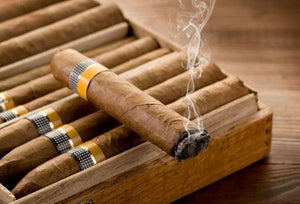The packaging of individual cigars, like humidors, has gone through a long development process. Single cigar packaging is no exception. Common ones on the market now are simple installation and aluminum tube installation.
1. Simple decoration
Simple packaging is just a cigar with a cigarette label on it. Many Cuban cigars are so simple. In fact, there were no cigarette labels at first. Starting in the 1870s, cigarette labels were designed on cigar packages.
Generally speaking, a cigar only has one label.
Some commemorative models, limited editions or special editions will have a special logo added to the original cigarette logo.

Sometimes subscripts are added, usually for some special meaning. The picture below is a commemorative eggplant with a footmark launched for the 50th anniversary of Cohiba.
2. Cellophane packaging
In the mid-1930s, cellophane was used in Cuban cigars until 1992. Most Cuban cigars (even Cohibas) were once packaged in cellophane.
Since 1992, cellophane packaging has generally been limited to machine-made cigars. The primary products of handmade cigars are also packaged in cellophane.
3. Cedar veneer wrapping
The use of cedar bark is to add the aroma of cedar wood to the cigar. At the same time, the cedar paper can protect the cigar from some physical damage such as collision. The cedar wood can be left on while the cigars are being cured. Cellophane, aluminum tubes, glass tubes, aluminum foil, etc. all need to be removed.
4. Paper towel packaging
Fonseca is currently the only cigar brand wrapped in tissue paper. The paper towel does not have any smell or moisturizing function, it just wraps the eggplant body to prevent some friction.
Paper towels can be placed in the humidor together during maintenance, but they actually don't have much effect. However, it must be removed when smoking.
5. Aluminum foil wrapping
Foil wrapping for cigars began in the 1920s. However, the cost of aluminum foil wrapping is relatively high. By the 1940s, except for some high-end cigar boxes and some commemorative editions, aluminum foil wrapping was rarely used.
The current aluminum foil is actually a natural silver aluminum foil. It can be plain or embossed and is used to completely or partially wrap the cigar.
Some packages:
Complete package:
6. Gold foil wrapping
Unlike aluminum foil, gold foil wrapping uses golden aluminum foil to partially wrap the cigar. Gold leaf can also be flat or sometimes patterned.
7. Cellophane and cedar wood
Cigars wrapped in cellophane and cedar usually indicate machine-made cigars. This form of packaging has been discontinued.
8. Aluminum tube
Aluminum tubes first appeared in the mid-1940s and were quite common by the 1950s. The aluminum tube can help provide short-term moisture and prevent the cigar from drying out too quickly. It also protects cigars from physical damage.
But when placing it in the humidor, you need to remove the cigar from the aluminum tube. However, experienced maintenance experts can use the relatively small sealing environment of the pipe to adjust the humidity in the pipe to adjust and maintain some "problem eggplants".
Aluminum pipes are generally lined with thin cedar wood chips.
Since 2006, Habanos SA has used recolored standard tubes and new premium tubes, replacing the original aluminum tubes. The original aluminum tube was basically silver with black text printed on it.
The new tubes used now are mostly colored tubes, and the text is mostly colored.
In 2008, Travel Retail Select Pack released a super premium humidifier tube. It consists of two independent tubes, upper and lower, containing humidified sea. The upper part of the humidification tube is a transparent plastic tube, and the lower part is an aluminum tube with a drill.
9. Glass tube
Glass tubes were introduced around the mid-1940s and became common in the 1950s and 1960s. But its use basically stopped in the mid-1970s. The glass tube has a plastic push-fit cap.
10. Plastic pipe
Plastic tubes can be clear or opaque, with top caps. Their current use is limited to machine-made cigars. For example, Guantánamo.
11. Cedar pipe
Cedar wood pipes are specialty pipes discontinued by the Davidoff brand. No longer in use.
12. Carton packaging
These are "soft pack" cardboard boxes, each containing one cigar. Then 3 to 5 pieces of cardboard packaging are put into large packaging boxes.
Cohiba Century also has this cardboard packaging:
13. Small sliding lid box/painted small sliding lid box
A small slide-top box that usually contains only one round cigar. This kind of packaging is also called "coffin box". Generally, only high-end expensive cigars or large cigars will use this kind of packaging. The painted small sliding lid box is the same as the unpainted small sliding lid box. After painting, the box has a varnish finish.
14. Aluminum foil small sliding lid box
Small unpainted slide-top box containing one or more cigars wrapped in foil.
15. Coiled snake outfit
The word "coiled snake" as a packaging word means that three cigars are tightly entwined and twisted in a spiral. Today's coiled snakes are all handmade, and each coiled snake is packed in a wooden sliding lid box.
























